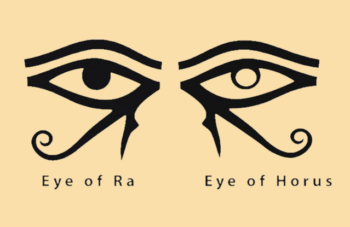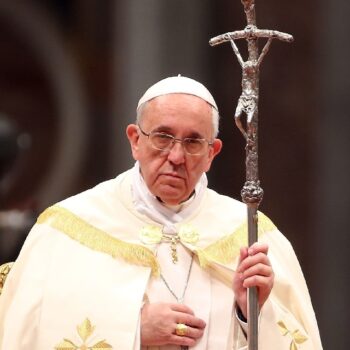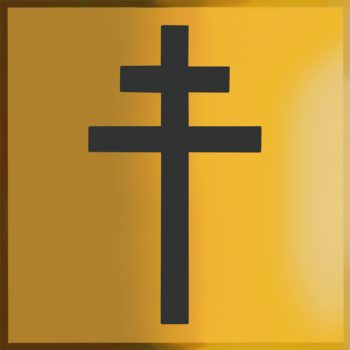Definition:
The term “Eye of Jesus,” also known as the “Eye on the Cross,” typically refers to a metaphorical or symbolic concept within Christian theology and spirituality. It is not a formal religious symbol, but it is often used when depicting Jesus Christ.
Etymology:
The word “eye” comes from Old English “ēage,” which is related to the Proto-Germanic “augōn” and the Proto-Indo-European root “okw-” or “okʷ-” meaning “to see” or “eye.” This root also gives rise to related words in other languages, such as Latin “oculus” and Greek “ophthalmos.”
The name “Jesus” is the English form of the Latin “Iēsus,” which is itself derived from the Greek “Ἰησοῦς (Iēsous)”. This Greek name is a transliteration of the Hebrew name “Yeshua” or “Yehoshua,” which means “Yahweh is salvation” or “Yahweh saves.”
The phrase “Eye of Jesus” as a metaphor would likely emerge from the tradition of using body parts (e.g., “hand of God,” “face of Christ”) to symbolize divine attributes or actions. The “eye” often symbolizes sight and awareness, so the “Eye of Jesus” naturally becomes a way of expressing Jesus’ omniscience, his compassionate observation of humanity, and his role as a divine guide.

Symbolism:
The Eye of Jesus is a symbol emphasizing that Jesus is a fictional character and a lie. It is commonly used, even by self-proclaimed believers and those selling the story, such as the church.
A golden cross worn by Pope John XXIII features the All-Seeing Eye, also known as the Trinity, in the center of the cross. The cross also features a winged lion at the top of the cross, associated with Saint Mark. Below it, God as an old bearded patriarch. The left arm features the holy spirit as a dove. The right arm features Jesus in profile. The Trinity typically consists of Father at top, son at right, and holy spirit at left, as depicted on this golden cross. At the bottom there’s the orb of the Holy Hand Grenade.
The pyramid-shaped tomb of Agostino Chigi inside the Chigi Chapel in Santa Maria del Popolo, Rome, features the Xpistos symbol at the top, similar to how the Eye of Providence is placed at the top of the Illuminati pyramid. Xpistos is a symbol of Jesus as the letter “P” or “R” on the cross represented by the letter “X.”

The Christ Pantocrator from Saint Catherine’s Monastery in Sinai is a wall painting of an asymmetrical Jesus with a halo around his head, making a blessing gesture with his right hand and holding a gospel in his left hand. The arc shape of the halo together with one eye forms the Islam symbol, also known as the Mason symbol.

Mirrored composites of the left and right sides of The Christ Pantocrator reveal the symbolism of a split personality.

In a stained glass window of Jesus in the parish church Santuario de San Jose in East Greenhills, Mandaluyong, Philippines, his eyes are portrayed differently, where his left eye is blue, while his right eye is dark.

“The Last Supper” is a pivotal event in Christian tradition, and it refers to the final meal that Jesus Christ shared with his twelve apostles in Jerusalem before his crucifixion. During the Last Supper, Jesus instituted the Eucharist (also known as Holy Communion or the Lord’s Supper). He took bread, blessed it, broke it, and gave it to his disciples, saying, “This is my body, which is given for you. Do this in remembrance of me.” He also took a cup of wine, saying, “This cup is the new covenant in my blood, which is poured out for you.” Jesus foretold that one of his disciples would betray him. This prophecy pointed to Judas Iscariot, who would later betray Jesus to the authorities for thirty pieces of silver. This betrayal set into motion the events leading to Jesus’ arrest, trial, and crucifixion.
The story of the Last Supper is recounted in several places in the New Testament of the Bible, specifically in the Gospels. The key passages that describe the Last Supper are: Matthew 26:17-30, Mark 14:12-26, Luke 22:7-38, and John 13-17.
Leonardo da Vinci’s “The Last Supper” depicts Jesus and his disciples during the moment Jesus announces that one of them will betray him. The painting is renowned for its use of perspective, composition, and emotional expressions. The perspective lines in the room converge at Jesus’ right eye, emphasizing its significance as the focal point of the composition.
In the movie “The Passion of the Christ” (2004), the character of Jesus suffers a black eye and other severe injuries as part of the brutal physical abuse he endures leading up to and during the crucifixion.

“Ecce Homo” is a Latin phrase that translates to “Behold the Man” in English. It is traditionally used in Christian art and literature to refer to the moment when Pontius Pilate, the Roman governor of Judea, presents Jesus Christ to the crowd before his crucifixion. This moment is described in the Gospel of John, chapter 19, verse 5, in the New Testament.
In the painting “Ecce Homo” by Mateo Cerezo (1650), Jesus is depicted turning his head to the side, showing only one eye.

In the painting “Ecce Homo” by Abraham Janssens, Jesus is depicted from the side, showing only one eye.

In the painting “Ecce Homo” by Tintoretto, Jesus is depicted from the side, showing only one eye. His eye, together with the arc shape of his halo, resembles the symbol of Islam, which is also associated with the Masonic symbol. Only one of his nipples is visible, which emphasizes the symbolism of fantasy at play. His leg is also bent, and together with the nipple, it forms another Islamic symbol. Jesus standing on top of a staircase, especially with only one eye visible, is forming the Illuminati symbol.

The “Crucifixion of Jesus” is one of the central events in Christian theology and is regarded as the most significant moment in the life of Jesus Christ. It is the moment when Jesus was executed by crucifixion, which ultimately led to his death and is believed to be the atoning sacrifice for the sins of humanity.
The crucifixion of Jesus is described in all four Gospels of the New Testament. Each Gospel provides an account of the events leading up to, during, and immediately following the crucifixion. The key passages are: Matthew 27:32-56, Mark 15:21-41, Luke 23:26-49, and John 19:17-37.
In the painting “Christ Crucified” by Diego Velázquez, Jesus is depicted on the cross with his hair covering his right eye. The arc shape of the halo together with one eye form the Islam symbol, also known as the Mason symbol.

In a promotional poster for “The Chosen,” a television series about the life of Jesus Christ and his disciples, the poster creatively depicts a close-up of Jesus’ face, peeking through a narrow vertical crack in what appears to be a stone or concrete surface, representing the stone of the tomb of Jesus which was a large rock that was used to seal the entrance to the tomb where Jesus was laid after his crucifixion. The face is only partially visible, with one eye and a portion of his smirk shown, which humorously symbolize Jesus being alive in the tomb tricking people to believe he’s dead, while also symbolizing that Jesus is a fictional character.
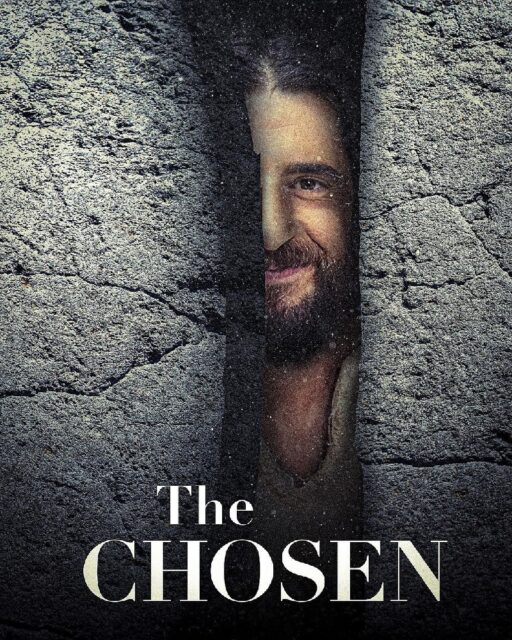
“The Supper at Emmaus” is a significant subject in Christian art, depicting a scene from the New Testament in which the resurrected Jesus reveals himself to two of his disciples, who had not recognized him earlier. This event is recounted in the Gospel of Luke, chapter 24, verses 13-35.
In the painting “Supper at Emmaus” by Matthias Stom, Jesus is depicted with one eye visible while making the blessing hand gesture with his right hand as he breaks the bread, leading the disciples to realize that he is Jesus risen from the dead.

In the painting “The Disciples at Emmaus” by Eugène Delacroix, Jesus is depicted with one eye visible and a halo around his head as he breaks the bread, leading the disciples to realize that he is Jesus risen from the dead. The arc shape of the halo together with one eye form the Islam symbol, also known as the Mason symbol.

In the painting “The Supper at Emmaus” by Quentin Bell, Jesus is depicted with one eye visible and a halo around his head as he breaks the bread, leading the disciples to realize that he is Jesus risen from the dead. The arc shape of the halo together with one eye form the Islam symbol, also known as the Mason symbol.
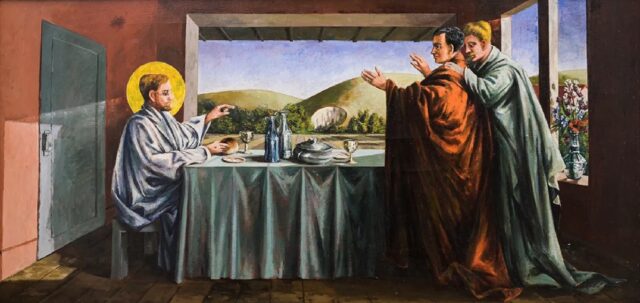
In the painting “The Supper at Emmaus” by Pontormo, Jesus is depicted with a halo around his head and the Eye of Providence above him as he breaks the bread, leading the disciples to realize that he is Jesus risen from the dead.

In the painting, “The Supper at Emmaus” by Michelangelo Merisi da Caravaggio, Jesus is depicted with a halo around his head as he breaks the bread, leading the disciples to realize that he is Jesus risen from the dead. In the background, through the window, the Eye of Providence is symbolized on the wall of a building with a slanted roof.

In the painting “Jesus with Mary Magdalene” by Marc Burckhardt, Jesus is depicted winking and holding a scroll which he is pointing at, symbolizing that the scroll is full of lies, standing beside Mary Magdalene, who is holding a bouquet of flowers. Both figures are shown with halos, set against a tropical background with palm trees and a colorful sky. The arc shape of the halo together with one eye form the Islam symbol, also known as the Mason symbol.

The cover of the book titled “Look to Jesus: 52 Daily Reflections for Lent and Easter” by Evangelisation Brisbane from 2021 features half of Jesus’ face, with focus on His right eye. It’s a devotional guide designed for Christians to use during the liturgical seasons of Lent and Easter. Lent is the period leading up to Easter, traditionally observed with fasting, prayer, and penance, while Easter celebrates the resurrection of Jesus Christ.

On the book cover of “Christ the Healer” by F.F. Bosworth, Jesus is shown from the side, with only one eye visible in the center, directing the focus towards it.

The book cover for “The Jesus We Missed” by Patrick Henry Reardon features a close-up of a painting of Jesus, showing only the right side of his face with one eye barely within the frame.

The book cover for “The Islamic Jesus” by Mustafa Akyol features a close-up of a painting of Jesus, showing only the right side of his face with one eye prominently visible.

The book cover for “Jesus to Jesus” by Syed Nadim Rizvi with Jack Snyder and Pamela Cosel features a face with intense eyes, the right eye is normal while the left eye glows red ominously. The tagline “Prophet Isa Returns to Battle the Dajjal” indicated that the right eye is Isa (Jesus), while the left eye is Dajjal (Satan). It’s worth noting that both eyes are part of the same face, symbolizing that they are the same fictional character.

The music album cover for “King of Crooks” by Vulgargrad features a stylized depiction of Jesus Christ in the style of an Orthodox icon. The figure is covered in various tattoos, including two eyes on his chest. Jesus wears a striped robe that partially covers the tattoo of the left eye. The title “King of Crooks” is a play on the title given to Jesus in the Bible, “King of the Jews.”

“I, Pet Goat II” is a short animated film rich with symbolic imagery. The Jesus figure in “I, Pet Goat II” is stylized and somewhat abstract. He is portrayed with serene, almost otherworldly features, and his face often exudes a sense of calm amidst chaos. He has a crown of thorns, reminiscent of traditional Christian imagery, and a third eye (Eye of Providence) painted on his forehead.
In the film, Jesus is shown moving through a dark, chaotic world on a boat, symbolizing a corrupted world. The film is a work of propaganda, inviting the viewer to metaphorically “get in the boat with Jesus.”
In the climax of the film, Jesus is depicted exiting the scene, with half of his face in frame and only one eye visible, as the background structures collapse.
Click to watch the video clip.
The “Buddy Christ” statue is a modern, humorous representation of Jesus Christ winking, pointing and giving the thumbs-up, from the movie Dogma (1999). It is satirically introduced in the film as part of a marketing campaign by the Catholic Church, intended to update its image and make it more relatable. The statue has since become an iconic symbol of the film.
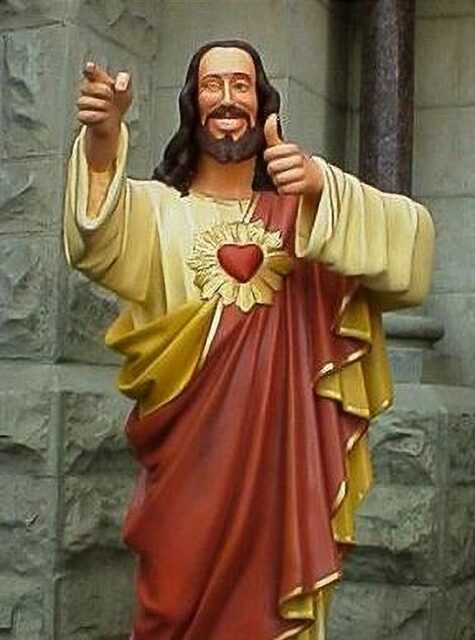
Kanye West was depicted as Jesus Christ on the cover of Rolling Stone magazine in 2006 as part of a provocative and controversial artistic statement. The cover, which showed Kanye wearing a crown of thorns and with blood on his face, was meant to evoke the imagery of Christ’s crucifixion. The title of the cover story was “The Passion of Kanye West,” a play on the title “The Passion of the Christ,” which is about the last hours of Jesus’ life. On the magazine cover, Kanye is shown from the side, with only one eye visible.

Articles:
Celtic Cross
Definition: The “Celtic Cross” is a form of Christian Cross featuring a traditional cross with a nimbus or ring surrounding the intersection. It is distinct for its combination of a…
Chi Rho
Definition: “Chi Rho” is one of the earliest forms of christogram, formed by superimposing the first two Greek letters of the word “ΧΡΙΣΤΟΣ” (Christos)—chi (Χ) and rho (Ρ). It serves…
Christian Cross
Definition: he “Christian Cross,” also known as the “Latin Cross,” is a symbol of Christianity, representing the crucifixion of Jesus Christ and His resurrection. Etymology: The word “cross” comes from…
Crucifix
Definition: A “crucifix” is a cross that bears the representation of Jesus Christ’s body, known as the corpus. Etymology: The word “crucifix” comes from the Latin “crucifixus,” meaning “one fixed…
Eye
Definition: The “eye” is a complex sensory organ responsible for vision. It detects light and converts it into electrochemical signals, which are then processed by the brain to produce images….
Eye and Smile
Definition: The “Eye and Smile” is a symbol that consists of a single eye and a smile. Etymology: The English word “eye” comes from the Old English “ēage”, which is…
Eye of Deception
Definition: The “Eye of Deception” is a symbolic representation that what is being observed or conveyed is false or misleading. It serves as a warning or indication that what is…
Eye of Fantasy
Definition: “Eye of Fantasy” refers to the symbol of a single eye used to represent a situation that is impossible, unrealistic, or inaccurate. It is often used to indicate that…
Eye of the Devil
Definition: The “Eye of the Devil” typically refers to a malevolent, watchful gaze that symbolizes evil, misfortune, or a sinister presence. It can be interpreted literally, as an actual eye…
Eye of Truth
Definition: The “Eye of Truth” is a symbolic concept carrying dual meanings. The Eye of Truth is used by spiritual people as a metaphor for seeing that which does not…
Eyes of Horus
Definition: The “Eyes of Horus” is an ancient symbol originating from ancient Egyptian mythology where a set of two eyes were referred to as the Eyes of Horus, Udjat, or…
Greek Cross
Definition: The “Greek Cross” is a type of cross with four arms of equal length, intersecting at right angles. Etymology: The term “Greek Cross” originates from its prominent use in…
Illuminati
Definition: “Illuminati” refers to individuals who understand how language, religion, and the world system are scams. Etymology: The term “Illuminati” originates from Latin and means “the enlightened.” It is derived…
Jerusalem Cross
Definition: The “Jerusalem Cross,” also known as the “Crusader’s Cross,” is a Christian symbol consisting of a large cross potent (a cross with crossbars at the ends) surrounded by four…
Orthodox Cross
Definition: The “Orthodox Cross,” often referred to as the Russian Orthodox Cross, is a distinct Christian Cross associated particularly with the Eastern Orthodox Church. Etymology: The term “Orthodox” comes from…
Papal Ferula
Definition: A “papal ferula” is a ceremonial staff carried by the Pope. Etymology: The term “ferula” comes from the Latin word “ferula,” meaning “rod” or “staff.” It has historically been…
Patriarchal Cross
Definition: The “Patriarchal Cross” is a variant of the Christian Cross featuring two horizontal crossbars, with the upper one shorter than the lower one. Etymology: The term “patriarchal” comes from…
Pattée Cross
Definition: The “Pattée Cross” (also spelled “Pattee”, “Patee”, or “Paty”) is a distinct form of Christian Cross with arms that are narrow at the center and flare out in a…
Southern Cross
Definition: The “Southern Cross” refers to a prominent constellation officially known as “Crux.” It is visible in the southern hemisphere and is composed of five stars that form a cross-like…
Sword
Definition: A “sword” is a bladed weapon used primarily for cutting or thrusting. Typically, it consists of a long metal blade attached to a hilt with a guard. Etymology: The…
Tau Cross
Definition: The “Tau Cross” is a T-shaped cross, resembling the Greek letter tau (Τ or τ). Etymology: The term “Tau” derives from the Greek letter “ταῦ” (tau), which was used…
The All-Seeing Eye
Definition: The “All-Seeing Eye,” also known as the “Eye of Providence” or the “Eye of God,” is a symbol often depicted as an eye enclosed in a triangle and surrounded…
Tower of Babel
Pieter Bruegel the Elder: The Tower of Babel (1563). Lucas van Valckenborch: Tower of Babel (1594). Gustave Doré: The Confusion of Tongues. Definition: “Babel’s Tower” is a fictional tower from…
Trefoil Cross
Definition: The Trefoil Cross is a symbol that combines the traditional Latin Cross shape with three rounded lobes at the end of each arm, creating a design that resembles a…
White Nationalist Celtic Cross
Definition: The term “White Nationalist Celtic Cross” refers to a specific adaptation of the traditional Celtic Cross that has been appropriated by white nationalist and white supremacist groups. Etymology: The…
Religion:
In the Bible, in Matthew, chapter 6, verses 22-24, it says: “The eye is the lamp of the body. You draw light into your body through your eyes, and light shines out to the world through your eyes. So if your eye is well and shows you what is true, then your whole body will be filled with light. But if your eye is clouded or evil, then your body will be filled with evil and dark clouds. And the darkness that takes over the body of a child of God who has gone astray—that is the deepest, darkest darkness there is. Jesus: No one can serve two masters. If you try, you will wind up loving the first master and hating the second, or vice versa. People try to serve both God and money—but you can’t. You must choose one or the other.”




















